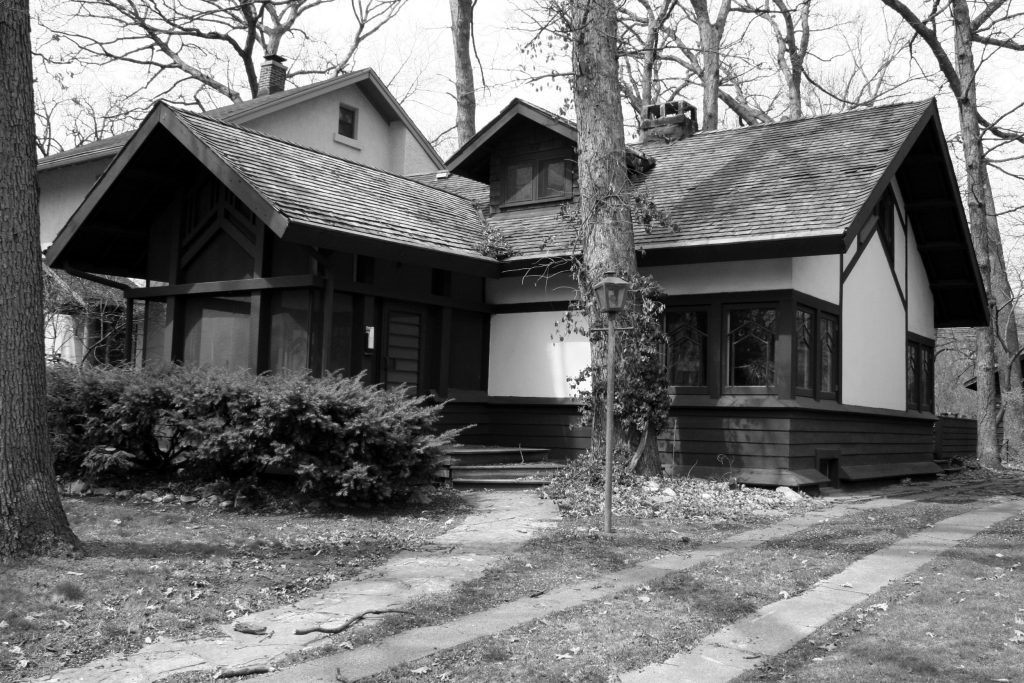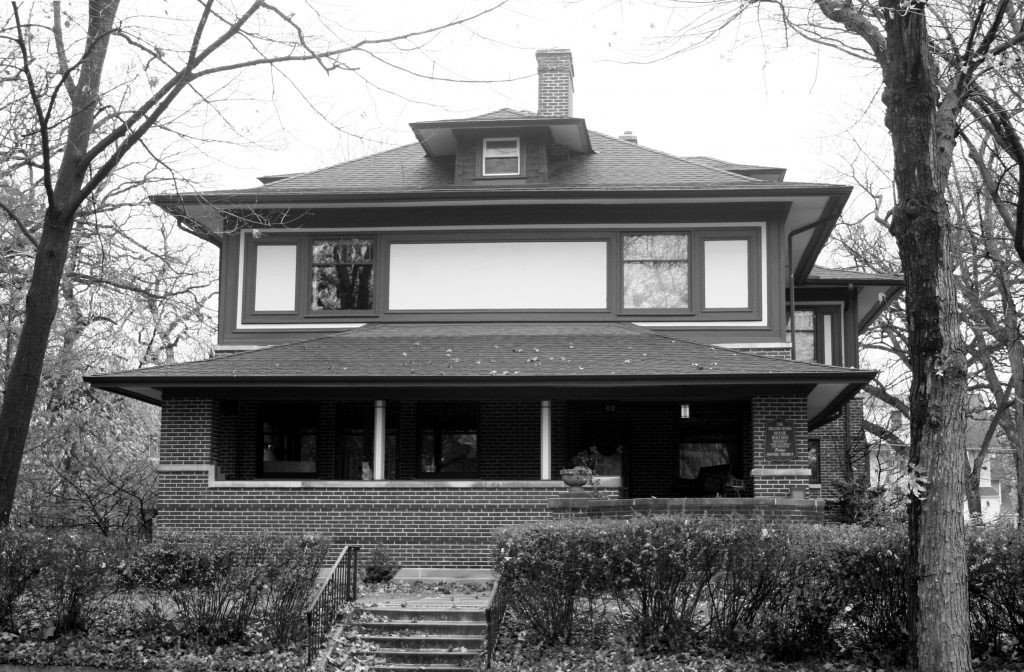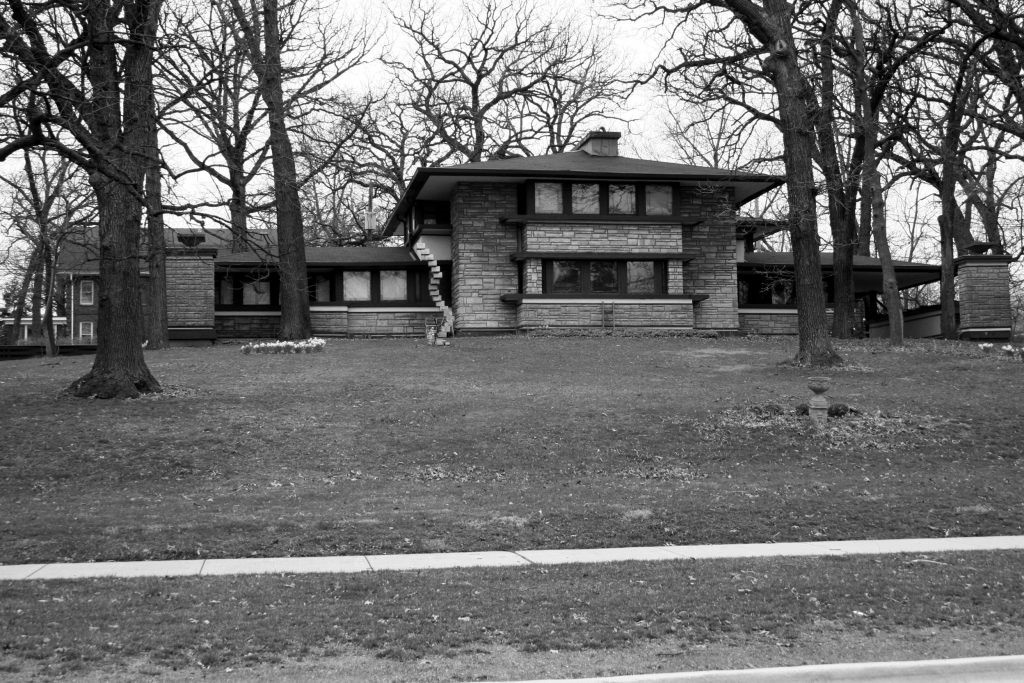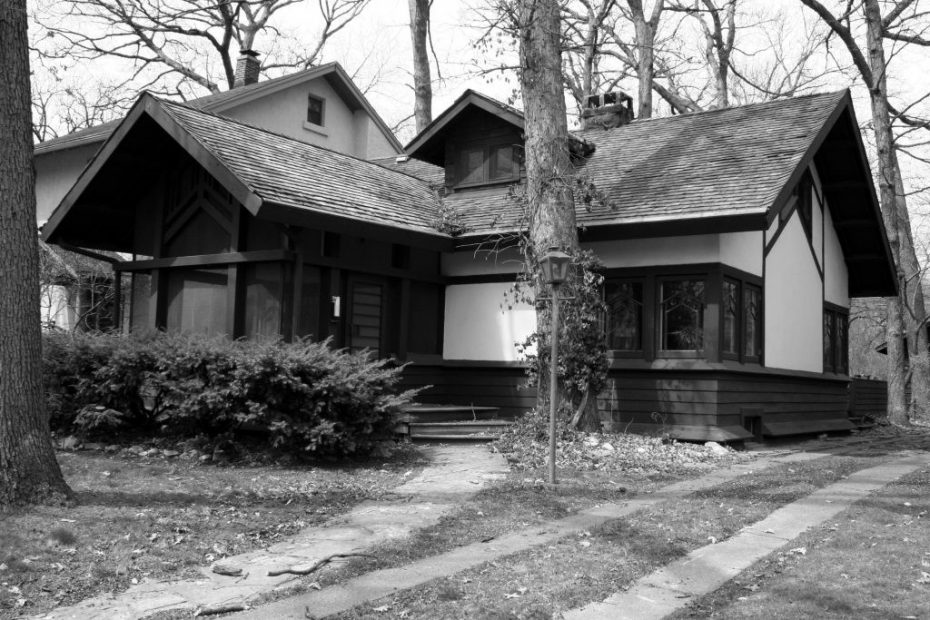
The iconic Prairie School of architecture, frequently regarded as America’s first indigenous residential architectural style, has well-documented beginnings in Chicago. The Prairie style was originated by architect Frank Lloyd Wright, whose developments redefined residential architecture in the first decade of the twentieth century. Prairie architecture takes inspiration not from historical precedents but from the Midwest’s most characteristic natural feature, the prairie. The horizontality of the Midwest landscape is emphatically expressed in the style’s massive and horizontal quality, as if rooted to the earth. Through a holistic approach to architectural design, Prairie architects connected exterior expression, free-flowing floor plans, interior furnishings, and landscape with fresh and original residential designs.
Prairie style homes are found mainly in Chicago’s middle- and upper-class suburbs, but Prairie aficionados will not be disappointed by the Prairie architecture in Beverly–Morgan Park, where over 160 examples of Prairie homes are within the Ridge Historic District, listed on the National Register of Historic Places. Often overlooked by city visitors are residential designs by master architect Frank Lloyd Wright and his followers such as Prairie School architects Walter Burley Griffin, George Washington Maher, Tallmadge & Watson, and Spencer and Powers. Local architects in the early 1900s such as Robert Seyfarth, Oscar McMurry, and Robert Skilleter Smith, were also influenced by the Prairie School movement swirling in the city. These architects interpreted and created characteristic Prairie designs for clients within Beverly–Morgan Park. Other Prairie residences are the products of local contractors, such as Evert Rich and William R. Ashton, who captured the fundamentals of the Prairie style.
Beverly–Morgan Park offered residential sites set within a varied, naturalistic landscape, perfectly suitable for free-flowing Prairie designs. It appears that Prairie architecture appealed to Beverly–Morgan Park clients who were particularly connected with Chicago’s educational, art, and architecture communities, yet there are residential designs built for upwardly mobile clients who simply wanted a restful retreat away from the bustle of the city.
Reasons for clients’ preference for Prairie design can be gleaned from H. Allen Brooks, expert author of the groundbreaking book The Prairie School: Frank Lloyd Wright and His Midwest Contemporaries. Brooks believes there are two reasons. First, the Midwesterner felt less social pressure than his or her East Coast counterparts to conform to traditional architectural styles. For reinforcement of their stylistic choices, Prairie homeowners could turn to articles in national magazines published in Chicago such as House Beautiful or Western Architect. Second, Brooks believes Prairie architecture offered homebuilders “a new experience in the act of living.” Given that the Prairie style promoted relaxed living in its flexible interior spaces and simplicity of materials, it appealed to Midwestern sensibilities and the suburban Chicago lifestyles of clients.[i]
What does Prairie architecture look like?
Prairie architecture in Beverly–Morgan Park flourished from 1904 until the United States entered World War I in 1917, yet there are examples from the early 1920s. Identifying features of the Prairie style include an emphasis on horizontality in its low-pitched roofs with wide overhangs, a dominant, broad, and flat rectangular chimney, and casement windows clustered in horizontal bands (frequently leaded windows in geometric designs). Roof types are typically low-pitched hipped roofs, but sometimes front-facing or side-gable roofs appear with broad overhangs. Also present are sweptback gables, where peaks project beyond their lower edges, or hipped roofs that may have flattened roof edges for a pagoda-like effect. Prairie exterior materials are often stucco, wood (most often horizontal board-and-batten siding) or brick (sometimes Roman brick) walls with limestone or concrete elements. These materials can be combined with different materials on the lower and upper story. Contrasting wall materials, including horizontal bands or half timbering for additional geometric interest, are sometimes used for trim. Prairie homes can be symmetrical with rectangular or square plans, but high-quality designs are typically asymmetrical, with a two- or three-story main section with lower wings or porches that are just as dominant. Porches and terraces linking the outdoors with the indoors are essential elements of the design. The porches often have massive square or rectangular piers supporting their roofs and contrasting caps on porch and balcony railings.
Frank Lloyd Wright in Beverly

Prairie School founder Frank Lloyd Wright (1867–1959) designed four homes in Beverly–Morgan Park between 1900 and 1917. The earliest is the Jessie Mae and William Adams House, 9326 South Pleasant, built in 1900–01[ii] for a contractor who constructed a number of homes for Wright. The home is a Chicago landmark, representing an important period of experimentation in Wright’s career with new forms and horizontality.
The area’s finest Frank Lloyd Wright commission is the Raymond W. Evans House at 9914 South Longwood. This Prairie School home was built in 1908[iii] atop the Blue Island Ridge, elevating many feet above the typical flat plain of the city. The Evans House plan is based on the influential Fireproof House, a concept to bring low-cost ($5,000) small residential designs to the masses. Yet the Evans House has also been compared to the masterful Ward Winfield Willits House in Highland Park, Illinois, with a two-story central pavilion where wings pinwheel around a central chimney. The design, which reaches horizontally across its hilltop site, was for client Evans, a sales manager and treasurer of the Picher Lead Company.[iv] In 1896 he married Alberta Wetzel Evans, an award-winning botanist who had collected every variety of wild flower native to the Illinois woods in one garden.[v] The couple’s links to Wright have not been recognized but may have been social in nature. Perhaps introductions were through the Illinois Athletic Club of which Evans was a member. The Evans’s were survived by one daughter, Eugenia Evans Garard, who sold the home in November 1928 to E. F. Wiegel, president of Ashland Sixty Third State Bank.[vi] This Prairie home’s original stucco facade is presently clad with mid-twentieth-century stonework, but the home is definitively Prairie.

The remaining two Wright designs in Beverly–Morgan Park are American System-Built Homes, another experiment in which Frank Lloyd Wright furthered his interest in affordable homes for all Americans. The Richards Company of Milwaukee oversaw the venture for which Wright created a series of prefabricated designs in various sizes for single-family and multifamily residency. Materials were ready-cut at the factory and then shipped to a site. Distribution was only through exclusive dealers of American System-Built Homes, such as the H. M Ellinwood Company of Berwyn, Illinois.
Marvin Ellinwood, Herbert M. Ellinwood’s brother, was a real estate developer and vice president of Burhans, Ellinwood & Company who believed in the concept. When he purchased the former twenty-five acre site of the Ridge Country Club, between 103rd Street, 105th Street, Hoyne, and Leavitt for a new subdivision in 1917,[vii] he built one of the homes. Within Ellinwood’s Ridgeholmes (also known as Ridge Homes) subdivision is a two-story, stucco American System Built Home at 10410 South Hoyne (1917),[viii] now known as the Burhans, Ellinwood & Company Model Home (Guy C. Smith House). P. D. Diamond & Company, a firm that experimented earlier in concrete block home design in Beverly–Morgan Park, was the general contractor. The American System-Built Homes (ASBH) venture was cut short following America’s entry into World War I but not before another ASBH home was constructed in Beverly. The H. Howard Hyde Home at 10541 South Hoyne was built for a cashier at International Harvester in 1917.[ix] Today, both the Hyde House and the Burhans, Ellinwood & Company Model Home are City of Chicago–designated landmarks.
Architect Walter Burley Griffin in Beverly-Morgan Park
Residential designs by Wright’s contemporaries are also in Beverly–Morgan Park. Of all of the Prairie School architects, Walter Burley Griffin (1876–1937) left an extensive architectural legacy in Beverly–Morgan Park and is honored with a street with his name. Walter Burley Griffin’s architecture is celebrated on 104th Place, between Prospect and Wood Avenues. Seven of his designs are part of the Walter Burley Griffin Place District, so designated by the City of Chicago. This landmark district of Griffin-designed homes along with another Prairie home designed by the architectural firm of Spencer and Powers constitutes the largest concentration of small-scale Prairie homes in Chicago.
Prairie School architect Walter Burley Griffin was educated at the University of Illinois, joined Wright’s practice in 1901, and started his own practice in 1906.[x] Griffin was undoubtedly influenced by Wright but developed his own signature approach to Prairie design. His Prairie designs exhibit building forms that are contained rather than free-flowing, massive corner piers that contrast with horizontal elements, sleeping porches, and attention to wall surfaces.[xi] After beginning his architectural practice, Griffin found his clientele among the developers and contractors for whom he designed speculative homes.[xii] When he connected with local real estate developer and contractor Russell Blount, Griffin designed a dozen Prairie School houses in Beverly–Morgan Park between 1909 and 1913, most of which are east of the Chicago, Rock Island and Pacific Railroad tracks.[xiii] Blount himself lived in a residential design by Griffin at the time he developed and sold other Griffin-designed homes in the rapidly growing Beverly community. The Prairie School residential designs in Beverly–Morgan Park attributed to Walter Burley Griffin include:
- Speculative House for R. L. Blount (Garrity, Edmund C. House), 1712 West 104th Place, 1910
- Frank N. Olmsted House, 1624 West 100th Place, 1910–11
- Helen Wells Blount House, 1724 West 104th Place, 1911
- Speculative House for Helen Blount (Van Nostrand, Harry G. House), 1666 West 104th Place, 1911
- Harry N. Tolles House, 10561 South Longwood, 1911
- Russell L. Blount House (II), 1950 West 102nd Street, 1912
- Speculative house for R. L. Blount (Salmon, Walter D. House), 1736 West 104th Place, 1912–13
- Speculative house for R. L. Blount (Jenkinson, Arthur G. House), 1727 West 104th Place, 1912–13
- Speculative house for R. L. Blount (Furneaux, Harry C. House), 1741 West 104th Place, 1913
- Speculative house for R. L. Blount (Clarke, William N. House), 1731 West 104th Place, 1913–14
- Speculative House for R. L. Blount (Williams, Ida E. House), 1632 West 104th Street, 1913–14
- William R. Hornbaker House, 1710 West 104th Street, 1914
Some of Walter Burley Griffin’s residential designs in Beverly–Morgan Park as well as the Von Holst & Fyfe–designed Maurice LeBosquet House at 10224 South Seeley (1911–12) were featured in the 1913 book Modern American Homes. At the time, Modern American Homes was one of America’s finest portfolios showcasing Prairie and Craftsman homes of the period. Chicago architect and former Wright employee Hermann Von Holst produced the portfolio. One featured home, a design by Walter Burley Griffin, is the Frank N. Olmsted House at 1624 West 100th Place. Constructed in 1910–11 by Russell L. Blount for electrician Frank Olmsted, this solid design was praised in Modern American Homes for its wide overhanging eaves, a terrace that serves as the home’s broad base, its natural materials, and grouped casement windows that all enhance its boxy form.[xiv] Both plans and elevations are included in this book.
Designs by Architect George Maher in Beverly-Morgan Park
Another Prairie architect, George Washington Maher, was a draftsman in the office of Joseph L. Silsbee, just like Frank Lloyd Wright. Maher entered his own practice in 1888 and left his mark in Beverly–Morgan Park.[xv] Maher’s Prairie designs are often solid, symmetrical, and monolithic, without free-flowing plans or unconventional entrances, but the horizontality of Prairie design prevails. Maher is noted particularly for his rhythm motif theory, where the architect selects a floral or plant design that is repeated in decorative elements and art glass windows for visual unity. The Arthur D. Heffron House, 10347 South Longwood, built in 1904[xvi] for a seed company buyer is characteristic of Maher’s Prairie designs. Dominating the front facade is a front corner porch with a flanged segmental arch opening. These segmental arches with short lateral flanges, a signature of Maher designs, are derived from English models, particularly the work of British Arts and Crafts architect and leader C. F. Voysey.[xvii]
Other Beverly clients of Maher’s were Heffron’s sister, Cora Heffron Murray, and her husband, George W. Murray. Instead of Prairie, they selected a more traditional Georgian Revival design. Maher also designed a handsome Prairie house for attorney Frank D. Thomason at 10432 South Longwood, built in 1907.[xviii] The Thomason House is decidedly symmetrical, with a central entry, and it is Prairie in its low, broad form and grouped second-floor windows. Again, Maher’s flanged segmental arch frames the central front entry.
Other Prairie School Architects Represented in Chicago’s Beverly-Morgan Park Neighborhood
Two other notable architecture firms of the Prairie School, Tallmadge & Watson and Spencer & Powers, designed Prairie homes in Beverly–Morgan Park. Tallmadge & Watson’s Louis A. Tanner House at 9640 South Longwood is a solid and handsomely detailed house designed to emphasize its quality of materials. The wood trim at the Tanner House is outstanding particularly in its use to emphasize the home’s horizontality at the cornice line and around the home’s grouped casement windows. Spencer & Powers, with whom Walter Burley Griffin shared loft space at Steinway Hall, maintained a partnership from 1905 until 1923. The firm’s two Prairie designs in Beverly are enduring with an emphasis on wall surfaces. The Harry F. Newland House, 1737 West 104th Place (1912–13) is a two-story example with horizontal board-and-batten siding on the lower level and stucco above; the Clyde I. Drake House, 10745 South Seeley, is a rare brick Prairie design built for an accountant in 1908–09. Robert C. Spencer, Jr., the firm’s designer, found inspiration for his Prairie designs more from English Arts and Crafts sources rather than Frank Lloyd Wright.[xix]
Aside from the high-style designs by colleagues and followers of Frank Lloyd Wright, some local architects constructed Prairie homes. A design of note is the John W. Ellis House, 9357 South Pleasant, built in 1908[xx] and designed by architect Robert E. Seyfarth of nearby Blue Island. Seyfarth, who worked for George W. Maher, designed a number of Prairie homes in Beverly–Morgan Park. Another handsome Prairie home is the Oscar L. McMurry House, 10429 South Seeley, built in 1909[xxi] and designed as the architect’s own home. McMurry was an instructor in the Normal Schools, notably as head of the industrial arts department from 1901 until 1929 at Chicago Teachers College/Normal School (now Chicago State University).
Local Designers and Contractors of Prairie Architecture
Some Prairie designs in Beverly–Morgan Park built by local contractors are frequently labeled “contractor Prairie.” They are always modest in scale with Prairie elements, characterized by simple rectangular massing, shallow-pitched roofs with broad overhang, broad front porches, and grouped windows. Fine examples of “contractor Prairie” homes include a speculative home for Evert Rich, 9606 South Vanderpoel (1913).[xxii] Contractor-builder Evert Rich constructed at least twenty-seven homes in Beverly—Morgan Park between 1905 and 1920, of which five are Prairie. Most are two-story stucco designs with side-gable roofs and horizontal banding. Another local builder, William R. Ashton, dabbled in Prairie design. One example is the Eugene W. Knight House at 9144 South Damen (1913–14)[xxiii] whose massive, full-height corner piers with geometric caps contrast with the home’s horizontal banding and wood siding. The home was built for Knight, a manager of an advertising company.
Prairie architecture lost popularity following World War I when historic revival architecture gained wide-ranging appeal influenced by conservative tastes. Nevertheless, Prairie architecture regained some regional influence after World War II with Frank Lloyd Wright’s reemergence and his influence on what became known as Late Prairie architecture.
[i] Brooks, H. Allen. The Prairie School: Frank Lloyd Wright and His Midwest Contemporaries. New York: W. W. Norton & Company, 1972, p. 25.
[ii] City of Chicago Ancient Building Permit No. South 1. January 2, 1901.
[iii] City of Chicago Ancient Building Permit No. 8390, dated October 27, 1908.
[iv] Obituary. “Raymond W. Evans, Lead Company Official, Dies.” Chicago Daily Tribune. January 18, 1919, p. 15.
[v] Obituary. “Mrs. Albert Wetzell.” Chicago Daily Tribune. April 6, 1924, p. 10.
[vi] “Buys Home in Longwood Drive.” The Economist (Chicago). November 24, 1928, p. 1237.
[vii] “Acre Trading Holds Interest; New Subdivision.” Chicago Daily Tribune. January 28, 1917, p. G18.
[viii] City of Chicago Ancient Building Permit No. 47447, July 24, 1917, ledger book South 19, p. 268. Two-story FRAME residence, 34x38x20, Cost $8500.
[ix] City of Chicago Ancient Building Permit No. 46598, May 16, 1917, Book S19, p. 199. Two-story FRAME residence, 34x38x32, Cost $6000.
[x] Brooks, H. Allen. The Prairie School: Frank Lloyd Wright and His Midwest Contemporaries. New York: W. W. Norton & Company, 1972, p. 117.
[xi] Brooks, H. Allen. The Prairie School: Frank Lloyd Wright and His Midwest Contemporaries. New York: W. W. Norton & Company, 1972, p. 74.
[xii] Kruty, Paul. “Walter Burley Griffin: An Architect of America’s Middle West” in Walter Burley Griffin in America. Urbana and Chicago: University of Illinois Press, 1996, p. 22.
[xiii] Ibid.
[xiv] Von Holst, Hermann. Modern American Homes. Plate 2. 1913.
[xv] Brooks, H. Allen. The Prairie School: Frank Lloyd Wright and His Midwest Contemporaries. New York: W. W. Norton & Company, 1972, p. 34.
[xvi] City of Chicago Ancient Building Permit No. S13183, July 18, 1904, 2.5-story brick residence, 37x67x32, Cost $4000.
[xvii] Brooks, H. Allen. The Prairie School: Frank Lloyd Wright and His Midwest Contemporaries. New York: W. W. Norton & Company, 1972, p. 106.
[xviii] City of Chicago Ancient Building Permit No. 6978, May 31, 1907, for a two story brick residence, 44x26x30, Cost $4500.
[xix] Brooks, H. Allen. The Prairie School: Frank Lloyd Wright and His Midwest Contemporaries. New York: W. W. Norton & Company, 1972, p. 91.
[xx] City of Chicago Ancient Building Permit No. 8096, November 9, 1908, Two-story brick residence, 42x34x32, Cost $5000.
[xxi] City of Chicago Ancient Building Permit No. 13367, July 9, 1909, Two-story FRAME residence, 27x41x32, Cost $6900.
[xxii] City of Chicago Ancient Building Permit No. 13105, May 24, 1913, Ledger Book South 6, p. 257. Two-story stucco residence, 30×34, Cost $4000.
[xxiii] City of Chicago Ancient Building Permit No. 18199, November 1, 1913, Book S 6, p. 592. Two-story frame residence, 28x32x26, Cost $5500.
